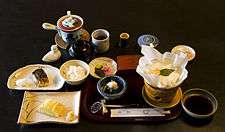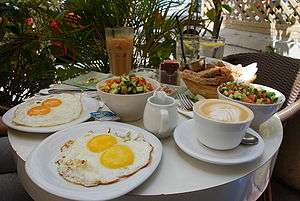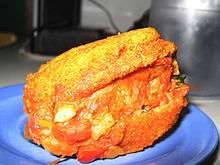Breakfast
| Part of a series on |
| Meals |
|---|
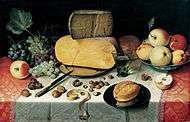 |
| Meals |
| Components and courses |
| Related concepts |
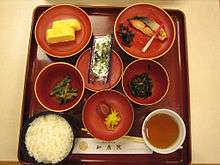

Breakfast is the first meal of a day, most often eaten in the early morning before undertaking the day's work.[1] Among English speakers, "breakfast" can be used to refer to this meal or to refer to a meal composed of traditional breakfast foods (such as eggs, porridge and sausage) served at any time of day. The word literally refers to breaking the fasting period of the prior night.[2]
Breakfast foods vary widely from place to place, but often include a carbohydrate-rich food such as grains or cereals, fruit, vegetables, a protein-rich food such as eggs, meat or fish, and a beverage such as tea, coffee, milk, or fruit juice. Coffee, milk, tea, juice, breakfast cereals, pancakes, waffles, sausages, French toast, bacon, sweetened breads, fresh fruits, vegetables, eggs, baked beans, muffins, crumpets and toast with butter, margarine, jam or marmalade are common examples of Western breakfast foods, though a large range of preparations and ingredients are associated with breakfast globally.[3]
Effect on health
With breakfast commonly referred to as "the most important meal of the day", particularly for children,[4][5] some epidemiological research indicates that having a breakfast might lower risk of metabolic disorders and cardiovascular diseases.[6] While current professional opinions are largely in favor of eating breakfast,[4] some contest its "most important" status.[7]
The influence of breakfast on managing body weight is unclear.[8]
History
The Old English word for dinner, disner, means to break a fast, and was the first meal eaten in the day until its meaning shifted in the mid-13th century.[9] It was not until the 15th century that “breakfast” came into use in written English to describe a morning meal,[2]:6 which literally means to break the fasting period of the prior night; in Old English the term was morgenmete meaning "morning meal."[10]
Asia
Myanmar
In Burma the traditional breakfast is htamin jaw, fried rice with boiled peas (pè byouk), and yei nway jan (green tea), especially among the poor.[11]
Glutinous rice or kao hnyin is steamed and wrapped in banana leaf often served with peas as kao hnyin baung with a sprinkle of crushed and salted toasted sesame. [11] Equally popular is the purple variety of rice known as nga cheik which is cooked the same way and called nga cheik paung. Si damin is sticky rice cooked with turmeric and onions in peanut oil which is served with crushed and salted toasted sesame and crisp fried onions. Assorted fritters such as baya jaw (urad dal) are often served as a complement.
Nan bya or naan (Indian-style flatbreads) again with pè byouk or simply buttered, is served with Indian tea or coffee. It goes well with hseiksoup (mutton soup).[11]
Fried chapati, blistered like nan bya but crispy, with pè byouk and crispy fried onions is a popular alternative.[12]
Htat ta ya, lit. "a hundred layers", is flaky multi-layered fried paratha served with either pè byouk or a sprinkle of sugar.[13]
Eeja gway (Chinese-style fried breadsticks or youtiao) with Indian tea or coffee is another favourite.[11]
Mohinga,[14] perhaps the most popular of all, now available as an "all-day breakfast" in many towns and cities, is rice vermicelli in fish broth kept on the boil with chickpea flour or crushed toasted rice, lemon grass, sliced banana stem, onions, garlic, ginger, pepper and fish paste and served with crispy fried onions, crushed dried chilli, coriander, fish sauce and lime. Add fritters such as split chickpea (pè jan jaw), urad dal (baya jaw) or gourd (bu jaw), boiled egg and fried fish cake (nga hpè jaw).
China
As China is made up of many distinct provinces each with their own unique cuisine, breakfast in China can vary significantly from province to province. In general, basic choices include sweet or salty pancakes, soup, deep fried bread sticks or doughnuts (youtiao), buns (mantou), porridge (congee), and fried or soup-based noodles.[15] These options are often accompanied by tea or sweetened soy bean milk. However, condiments for porridge and the soup base tend to vary between provinces and regions. The types of teas that are served and spices that are used can also differ significantly between the provinces.
Hong Kong
Due to its near two centuries history as a British colony and proximity to China's Canton region, both English and traditional Cantonese style breakfasts are of somewhat equal popularity in Hong Kong, as well as the hybrid form of breakfast commonly offered in Cha chaan teng. Cha Chaan Teng breakfasts often include Hong Kong style milk tea, pan fried egg, bread, Cantonese noodles or Hong Kong style macaroni in soup.[16]
Traditional Cantonese breakfast may include dim sum, which include a variety of different ingredients and are prepared in numerous different forms from delicately wrapped baby shrimp steamed dumplings to sweet water chestnut cake. Each dish is designed to be sampled and diners can go through a large selection of dim sum quickly accompanied by a generous amount of good tea. Iron Buddha tea is the most common accompaniment, but other teas such as pu'er and oolong are also common.[17] Fried and rice-based noodles and cakes are also popular. In modern times, dim sum is commonly prepared and served in Yum Cha restaurants rather than home because of the skill and efforts involved in the preparation.
Japan
Breakfast in modern Japanese households comes in two major variations: Japanese style and Western style.[18] Japanese-style breakfasts are eaten widely in Japan, but often only on weekends and non-working days.[18] Younger Japanese couples may prefer Western-style breakfasts because they are generally less time consuming to prepare.[18]
The standard Japanese breakfast consists of steamed white rice, a bowl of miso soup, and Japanese styled pickles (like takuan or umeboshi).[18][19] A raw egg and nori are often served; the raw egg is beaten in a small bowl and poured on the hot rice[18] to make golden colored tamago kake gohan, whilst the nori (sheets of dried seaweed) is used to wrap rice.[18] Grilled fish and Japanese green tea are often served as well.[19]
Western-style breakfasts in Japanese households are similar to those in the United States. Japanese children often eat corn flakes and drink milk, hot chocolate or fruit juice. Japanese adults (especially younger ones) tend to have toast with butter or jam, eggs, and slices of vegetables. They often drink coffee or orange juice.[18]
Traditional Japanese inns (like ryokan) serve complete traditional breakfast.[18] Western-style hotels and restaurants in Japan generally offer a mix of the Western and Japanese styles.[18]
Korea
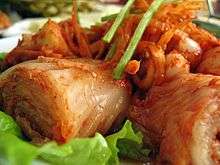
Traditionally, Korean breakfasts consist mainly of rice and soup dishes. These can include small amounts of fish or beef, and some form of broth, stew or porridge. Like all Korean meals, breakfast is usually served with banchan, or side dishes consisting of kimchi, steamed eggs and tofu.[20]
India
There is no standard Indian breakfast menu as almost each state in India has different specialties. However, one can broadly classify breakfast varieties in India into 2 types; North Indian and South Indian. The eastern and western parts of India also have individual breakfast items unique to their culture or state.
A typical south Indian breakfast consists of idli, vada or dosa[21] coupled with chutney and sambar. Many variations of these dishes exist such as Rava idli, thayir vadai (yogurt vada), sambar vada and masala dosa. Other popular south Indian breakfast items are pongal, bisibelebath (sambar rice), upma, and poori. The state of Kerala has some special breakfast items such as appam, parotta, puttu, idiyappam and palappam.[21]
A typical north Indian breakfast may either be a type of paratha or roti served with a vegetable curry, curd and pickles. There are several varieties of parathas available depending on the type of stuffing such as aloo (potato) paratha, Paneer (cottage cheese) Paratha, Mooli Paratha (Radish Paratha), etc.[22] Other popular breakfast items in the north are poori bhaji, poha and bhindi bhujia.
Among Bengals roti and curry are the general variants in breakfast. The menu may also include "Indian French toast" which is also known as "Bombay toast", chire bhaja (flaked rice fried in oil and salt is added to it according to taste),[23] and boiled eggs.
In Western India, a Gujarati household may serve dhoklas, khakhras or theplas for breakfast, the most popular of which is methi thepla.[24]
-
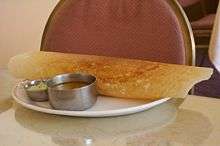
South Indian Dosa served with Chutney and sambar.
-
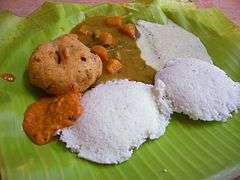
A south Indian breakfast with idlis and a vada, served with chutney and sambar.
-

Aloo Paratha
-

Dhoklas being sold in the market
In Maharashtra typical breakfast (Nashta) consists of 'Kande Pohe','Upma, 'Ukkad', Thalipeeth,[25]'Spiced Puree'. Sometimes 'Chapati Bhaji' or 'Chapati roll with tea' becomes breakfast.
Philippines
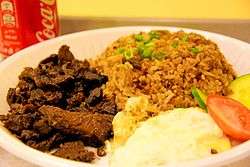
A traditional Filipino breakfast might include pandesal (small bread rolls), kesong puti (white cheese), champorado (chocolate rice porridge), sinangag (garlic fried rice), and meat—such as tapa, longganisa, tocino, karne norte (corned beef), or fish such as daing na bangus (salted and dried milkfish)—or itlog na pula (salted duck eggs). Coffee is also commonly served particularly kapeng barako, a variety of coffee produced in the mountains of Batangas noted for having a strong flavor.
Certain portmanteaus in Filipino have come into use to describe popular combinations of items in a Filipino breakfast. An example of such a combination order is kankamtuy: an order of kanin (rice), kamatis (tomatoes) and tuyo (dried fish). Another is tapsi: an order of tapa and sinangág. Other examples include variations using a silog suffix, usually some kind of meat served with sinangág and itlog (egg). The three most commonly seen silogs are tapsilog (having tapa as the meat portion), tocilog (having tocino as the meat portion), and longsilog (having longganisa as the meat portion). Other silogs include hotsilog (with a hot dog), bangsilog (with bangus (milkfish)), dangsilog (with danggit (rabbitfish)), spamsilog (with spam), adosilog (with adobo), chosilog (with chorizo), chiksilog (with chicken), cornsilog (with corned beef), and litsilog (with lechon/litson). Pankaplog is a slang term referring to a breakfast consisting of pandesal, kape (coffee), and itlog (egg).[26] An establishment that specializes in such meals is called a tapsihan or "tapsilugan".
Caribbean
Cuba
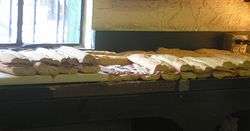
Breakfast in urban areas traditionally consists of café con leche that is sweetened and includes a pinch of salt. Toasted buttered Cuban bread, cut into lengths, is dunked in the coffee. In rural Cuba, farmers eat roasted pork, beans and white rice, café con leche and cuajada sweetened with caramel.[27]
Dominican Republic
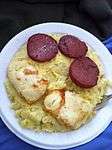
In the Dominican Republic, breakfast varies depending on the region. In the interior of the island it is accustomed to have breakfast with a side of vegetables, the green plantain or cooking plantain being the most popular. It is served boiled or mashed known as Mangú. In the capital, breakfast is more light. It includes coffee with milk or hot chocolate, along with bread, butter and cheese. Normally accompanied by orange juice and other juices of fruits typical to the region. Milk punch (milk, egg, nutmeg and malt) boiled eggs with "harina de negrito" or some other type of cornstarch. Traditional breakfast bread is a water-based bread.[28]
Jamaica
A Jamaican breakfast includes ackee and saltfish, seasoned callaloo, boiled green bananas, and fried dumplings.[29]
Central America
Panama
In Panama, breakfast is a heavy meal, especially in the interior of the country where hard labor requires it. It always includes black coffee (tinto) or with milk (called pintado) with any of these sides: corn tortillas, traditional white cheese (or queso del pais), another type of tortillas or "torrejas" made of wheat flour known as "hojaldres." Another traditional breakfast side is "bollo" made out of either corn, white corn, or coconut that is wrapped in corn leaves and "preña'o" (meaning with child) that means it's filled with some type of meat.

As protein, a large serving of beef liver with onion, scrambled or fried eggs, beef stew or "tasajo" (a type of beef jerky), pork rinds and different kinds of sausages like chorizo or morcilla are the most popular. These are also accompanied by: slices of green plantain or cooking plantain, "patacones" (double fried plantain), carimañolas (yuca filled with meat), as well as different bread pastries both savory and sweet. These large breakfasts are normally reserved for special occasions while everyday breakfasts consist of more traditional food from the west like toast, ham, cheese, jam etc.
It is important to mention that the prolonged US presence has also influenced urban areas of Panama by introducing meals like cereal with milk as well as pancakes with syrup as traditional breakfast meals.[30]
Costa Rica

In Costa Rica the most common breakfast is called "gallo pinto," which basically is made up of rice and beans (red or black) previously cooked. Sautéed in a pan with chile, onions, culantro (an herb typical to the region) and bean stock for color. It is accompanied with fried egg, cheese and fried plantain or cooking plantain. Black coffee as well as with milk are traditional drinks. As this is the most common breakfast of the country, in Limón Province they prepare gallo pinto with coconut milk instead.
Another popular breakfast food is the "chorreadas" which are basically savory sweet corn pancakes; they are usually accompanied with cheese or a type of sour cream called "natilla".[31]
Nicaragua
In Nicaragua the typical breakfast consists of "gallo pinto" (national dish made out of red beans and rice), eggs, cheese, corn tortillas and sweet plantains. Meals are normally accompanied by different juices and coffee.[32]
Guatemala
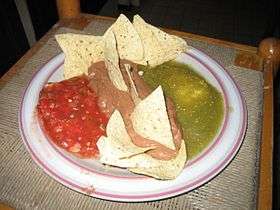
In Guatemala, breakfast consists of one or two eggs either fried, scrambled or boiled accompanied by baked/fried beans with coffee. With this comes fresh cream, fresh cheese and fried plantains (or cooking plantain). It is common to add hot sauce made out of "chiltepes" (a type of pepper). They are prepared raw or boiled, then they are grounded with some vinegar, chopped onions and chopped cilantro to make the hot sauce. A traditional egg dish prepared with both green and red sauces is called "huevos divorciados." In the eastern part of the country, specifically in Zacapa you can find "huevos a caballo" or (eggs on a horse) which is basically two fried eggs over roasted steak.
Other types of breakfast include milk cereals. The most common drinks are orange juice or other fruits, milk, atol (a milk pudding with chocolate) and corn starch. The coffee is normally served with sweet bread also called "pan de manteca" (or butter bread). [33]
Honduras

In Honduras it is typical to start the day with homemade bread, with coffee or a glass of milk. Then, a plate of food with beans, alongside eggs that can be scrambled or sunny side up, slivers of fried plantain (or cooking plantain), corn, tortillas, cheese and butter. Versions of egg preparation vary: "estrellados" which consists of just cracking the shell, in "torta" or omelette (beaten with some salt), scrambled or boiled. Another typical breakfast are the baleadas and tortillas with cheese; sometimes they are fried together with cheese in between.
In the "garífuna" culture, coffee is accompanied by "mínimo" bread (banana bread) or coconut bread. [34]
Europe
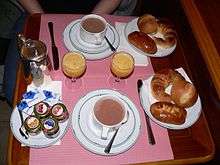
A typical Continental breakfast consists of coffee and milk (often mixed as Cappuccino or latte) or hot chocolate with a variety of sweet cakes such as brioche and pastries such as croissant, often with a sweet jam, cream, or chocolate filling.[35] It is often served with juice. The continental breakfast may also include sliced cold meats, such as salami or ham, and yogurt or cereal.[36] Some countries of Europe add a bit of fruit and cheese to the bread menu, occasionally even a boiled egg or a little salami.
Albania
In Albania the breakfast often consists of a scone, milk, tea, eggs, jam or cheese. Meat is not preferred during the breakfast and it is usually substituted for seafood such as canned sardines or tuna which is typically served with condiments such as mustard or mayonnaise. Wholegrain cereals and pastries are mostly consumed by children.
Croatia
In Croatia the base is a continental breakfast with a variety of pastries with or without fillings (marmalade, chocolate, cheese, ham, nuts, poppy) and fermented milk products (yogurt, soured milk, soured cream). Cold cuts, such as prosciutto, ham, salami, kulen, bacon, and various cheeses, are also favored.[37] Fried eggs or omelet and Vienna sausage with mayonnaise, mustard or ajvar are very often consumed. In continental parts sir i vrhnje (cottage cheese with soured cream and some spices) is traditional. Coffee is much preferred over tea (mostly herbal tea).
Denmark
A typical breakfast in Denmark consists of slices of rye bread ('rugbrød') with yellow cheese, a soft-boiled egg – or more rarely – ham, salami or liver spread ('leverpostej') or it may consist of breakfast cereals such as oatmeal, corn flakes, yogurt being popular options. White bread or bread rolls (rundstykker) with yellow cheese and different kinds of jams, usually made from berries or citrus fruits, and other toppings, accompanied by coffee, or tea. Weekends or festive occasions may call for Danish pastries (wienerbrød), chocolate, or a bitters, such as Gammel Dansk.[38]
Finland
Breakfast usually consists of coffee or tea with open sandwiches. The sandwich is often buttered (with margarine), with toppings such as hard cheese or cold cuts.[39] Finns usually do not have sweets on their breads such as jam, or chocolate. Sour milk products such as yogurt or viili are also common breakfast foods, usually served in a bowl with cereals such as corn flakes, muesli, and sometimes with sugar, fruit or jam. Oatmeal or mixed grain porridge may also be served, usually topped with butter.
France
In France, a typical domestic breakfast consists of a cup of coffee, often café au lait, or hot chocolate, sometimes accompanied by a glass of orange or grapefruit juice. The main food consists of sweet products such as tartines (slices of baguette or other breads spread with butter, jam or chocolate paste), sometimes dunked in the hot drink. Brioches and other pastries such as croissants, pains au chocolat (chocolatine) and pains aux raisins are also traditional, but more of a weekend special treat.[40] Other products such as breakfast cereals, fruit compote, fromage blanc, and yogurt are becoming increasingly common as part of the meal. A traditional French breakfast does not include any savory product, but breakfast buffets in hotels often include ham, cheese and eggs.
Germany and Austria
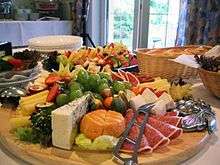
The typical German breakfast consists of bread or bread rolls, butter, jam, ham, cheeses, meat spreads, cold cuts, hard- or soft-boiled eggs and coffee. Cereals have become popular, and regional variation is significant. Yogurt, granola and fruit (fresh or stewed) may appear, as well as eggs cooked to order (usually at smaller hotels or bed-and-breakfasts).[41] A second breakfast is traditional in parts of Germany, notably Bavaria where it is called Brotzeit (literally "bread time").
Greece
Home breakfasts in Greece include bread with butter, honey or marmalade with coffee or milk. Breakfast cereals are also eaten. Children also eat nutella type cream on bread. No breakfast at all is common.[42] Various kinds of savoury pastry (Tyropita, spanakopita, and bougatsa) are also eaten for breakfast, also by those eating out, usually accompanied with Greek coffee or Frappé coffee. Traditional Greek breakfast (hot milk, fresh bread, butter and honey, or yogurt) was also available in special "milk shops" (in Greek Galaktopoleia – Γαλακτοπωλεία γαλακτοπωλείο). Milk shops were phased out between 1970 and 1990 – there are very few left, one is in Athens[43] and some in small towns.
Hungary
In Hungary people usually have a large breakfast. Hungarian breakfast generally is an open sandwich with fresh bread or a toast, butter, cheese or different cream cheeses, túró cheese or körözött (Liptauer cheese spread), cold cuts such as ham, liver pâté (called májkrém or kenőmájas), bacon, salami, beef tongue, mortadella, disznósajt (head cheese), different Hungarian sausages or kolbász.[44] Even eggs, (fried, scrambled or boiled), French toast called bundás kenyér and vegetables (like peppers, bell peppers, tomatoes, radish, scallion and cucumber) are part of the Hungarian breakfast. Sometimes breakfast is a cup of milk, tea or coffee with pastries, bread rolls or crescent-shaped bread (kifli), toast, pastries with different fillings (sweet and salty as well), butter, jam or honey and a bun or a strudel Hungarian cuisine,[45] or cereal like muesli and perhaps fruit.
Italy
The traditional breakfast in Italy simply consists of a caffè latte (hot coffee with milk) with bread or rolls, butter and jam – known as prima colazione or just colazione. Fette biscottate (a cookie-like hard bread often eaten with hazelnut chocolate spread or butter and jam) and biscotti (cookies) are commonly eaten. Hot coffee may be sometimes replaced by hot tea, depending on personal taste. Children often drink hot chocolate, plain milk, hot milk with barley coffee, or hot milk with very little coffee. Cereals, yogurt and fruit juices are also common. If breakfast is eaten in a bar (coffee shop), it is composed of cappuccino and cornetto (frothed hot milk with coffee, and a pastry).[46] It is not uncommon for Italians to have a quick breakfast snack during the morning.
Latvia
Typical Latvian breakfast usually consists of open sandwiches with toppings made of vegetables, fish, eggs or cheese. Just like Finland it is often buttered with margarine. Curd mixed with vegetables and salt as well as other sour milk products are very popular as well. Very often light oat porridge is eaten too.[47] In general light, sour and salty tasting food is common for morning meal. Latvians usually drink coffee for breakfast.
Malta
On the island of Malta, breakfast integrates both British and continental elements. Usually the Maltese start their day with a bowl of cereal mixed with milk, sometimes with a cup of coffee or tea. Marmalade/jams or even chocolate spreads are also common on bread or toast. Today cereal bars are also becoming a common type of breakfast on the island. The traditional English breakfast of eggs, sausages and fried bacon was also popular among the Maltese, especially on Sundays, due to the strong British influence on the island but this has diminished almost completely, as locals have rediscovered a more Mediterranean and continental diet over the recent years. Hotels usually serve both a continental as well as a full English breakfast. Prayers are often said before breakfast in order to bless the meal.[48]
Netherlands
For breakfast, the Dutch typically eat sliced bread with butter or margarine and three choices of toppings: dairy products (numerous variations of cheese), a variety of cured and sliced meats, or sweet or semi-sweet products such as jam, syrup (from sugar beets or fruit), honey, Kokosbrood (a coconut product that is served thinly sliced like sliced cheese) or peanut butter. Another type of sweet toppings are the chocolate toppings; the Dutch have chocolate toppings in all variations: hagelslag (chocolate sprinkles), chocoladevlokken (chocolate flakes) (both typically Dutch), and chocoladepasta (chocolate spread).[49] Tea, dripolator coffee, milk, and juice are the most popular breakfast beverages. Breakfast may also include raisin bread and fried or boiled eggs. On special occasions, such as Easter, Christmas, Mother's Day etc., breakfast is usually the same, but with a wider range of choices (i.e. premium cheeses, special ham, hot buns, croissants etc.).
A 2012 opinion poll concluded that the Dutch believe that breakfast should be a more important meal than it is and that more time should be spent on it; almost three-quarters of those polled ate their sandwiches in less than fifteen minutes, and blame for an all-too quick breakfast was placed on "fast" breakfast products. A perfect "weekend breakfast" for the Dutch contained coffee or tea, fresh-baked bread rolls (and croissants), and a boiled egg. The poll also concluded that men are more interested than women in having breakfast with their partner.[50]
Norway
80% of Norwegians eat breakfast daily, mostly at home. The most common breakfast is open sandwiches, often whole wheat bread, with cheese like brunost and Norvegia, cold cuts,[51] leverpostei, jam etc. Common drinks are water, coffee, milk and juice. Another common breakfast is breakfast cereals like corn flakes eaten with milk, kulturmelk or yogurt. Whole-grain porridges with regular milk or butter are popular. More ample breakfasts may include fish, cheese, eggs, bacon, breads, and hot and cold cereals eaten in various combinations.[47]
Poland
The traditional Polish breakfast is a large spread with a variety of sides eaten with bread or toast. Sides include various cold cuts, meat spreads, the Polish sausage kielbasa, tomatoes, Swiss cheese, and sliced pickles. Twaróg, a Polish cheese, is the breakfast classic and comes in many forms. Twaróg can be eaten plain, with salt, sugar, or honey, or it can be mixed with chives into a cream cheese-like spread. Eggs are served often as the main breakfast item, mostly soft-boiled or scrambled. For a quick winter breakfast, hot oatmeal, to which cocoa is sometimes added, is often served. Jam spreads are popular for a quick breakfast, including plum, raspberry, and black or red currant spreads. Breakfast drinks include coffee, milk, hot cocoa, or tea. Traditionally, the Poles avoid heavy-cooked foods for breakfast.[52] For the most part, one will not see fried meats or potatoes in a classic Polish breakfast. Emphasis is placed on a large variety of foods to satisfy everyone at the breakfast table.
Romania
The traditional Romanian breakfast is milk, tea or coffee alongside (toasted) bread with butter or margarine and on top of it, honey or fruit jams or preserves. Sometimes the buttered bread is served savory instead of sweet, in which case the Romanians add cured meats, salami or cheese. Another option is to spread on a slice of bread some liver pâté. In the recent years, Romanians have also started to serve cereal with dried fruits and milk instead of the traditional breakfast, though that is not yet very wide spread.[53] According to a 2014 study, 35% of Romanians eat cooked dishes such as omelet or fried eggs and 15% eat sandwiches. Most people drink coffee and 67% serve Turkish coffee (made in an ibrik), though more and more people are starting to use drip or filter coffee.[54] While crêpes served with fruit preserves, jams or cheese have traditionally been served as desserts, in the recent years more Romanians have started to have them as breakfast during weekends.[55]
Russia
Traditional Russian breakfast are concentrated on kashas, or porridges – the most important staple in Russian nutritional culture, with buckwheat and oat, as well as semolina, serving as the three most important bases of such dishes, usually cooked on water or milk, as well as consumed with or without milk. Breakfast foods also include pancakes or oladushki.[56] Oladushki are made from flour and rise on yeast. Blini, or crepes, are also popular for breakfast and are also made with flour, but without the yeast. Sirniki, is a cheese form of pancake. Sirniki are made of tvorog (quark cheese), which can be eaten separately with honey for breakfast. Also, a popular dish is buterbrod, open sandwiches with cold cuts and cheeses.[57]
Serbia
In Serbia domestic breakfast may include: eggs in different forms (e.g. omelet with bacon, onion and feta cheese), canned fish or opened sandwiches with prosciutto or ham, feta cheese and salad (e.g. pickles). Different types of pies and pastry with various filings (e.g. Proja, Gibanica, Burek) are also served as the main dish.[37] Yogurt and coffee are preferred breakfast drinks. In the past it was a custom to drink Sljivovica before breakfast and after that Slatko with water.
Southeastern Europe
Bulgaria, Serbia, Bosnia, Montenegro, Macedonia, parts of Croatia. Breakfast usually consists of various kinds of savory or sweet pastry, with cheese, meat or jam filling. The most typical breakfast consists of two slices of burek and a glass of yogurt.[58] Breakfast also often consists of open sandwiches. The sandwich is buttered (with margarine), with toppings such as prosciutto and yellow cheese.
Spain
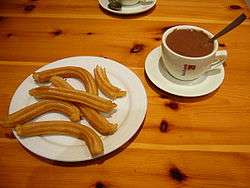
In Central Spain there is a special breakfast 'known as chocolate con churros – hot chocolate with Spanish-style fritters, which are extruded sticks of doughnut-like dough with a star-shaped profile covered in sugar. The chocolate drink is made very thick and sweet. In Madrid, churros are somewhat smaller and shaped like a charity ribbon . This meal is normally served in cafeterías but it is not a regular or usual breakfast at Madrid homes. The usual one is the same as in the rest of Spain: coffee with milk or Cola Cao, orange juice, biscuits or toasts, with butter and jam. In the North, East and West it is more common to have a cup of coffee (usually with milk) or Cola Cao and a toast with a choice of olive oil and salt, tomato and olive oil, butter, jam, pâté, jamón serrano (cured ham), and other options like sobrasada (a raw cured spiced sausage that is easy to spread),[59] and in Andalucia, pringá. Freshly squeezed orange juice is widely available in most places as an alternative for coffee. The breakfast is not often larger than these two items, because usually in late morning there is a break known as almuerzo when there is a snack. Sometimes, toast is replaced with galletas (a type of cookie made with flour, sugar, oil and vanilla flavour), magdalenas (a Spanish version of the French madeleine made with oil instead of butter) or buns.
Sweden
Breakfast in Sweden is generally an open sandwich made of a large amount of different types of soft bread or crisp bread, cold cuts, smörgåskaviar, cheese, cottage cheese, cream cheese, eggs, scrambled or boiled, pâté (leverpastej) with pickled cucumber, tomatoes or cucumber, or a toast with marmalade or maybe honey, juices, coffee, hot chocolate or tea. Breakfast cereals or muesli with milk, yogurt or filmjölk, currants and fruits are popular or warm whole-grain porridge with milk and jam (for example lingonberry jam).[60] Bilberry-soup (blåbärssoppa) and rose hip soup are also possible breakfast alternatives.
Switzerland
Swiss breakfasts are often similar to those eaten in neighboring countries. A notable breakfast food of Swiss origin, now found throughout Europe, is muesli[61] (Birchermüesli in Swiss German), introduced in 1900 by Maximilian Bircher-Benner for patients in his hospital.
Turkey
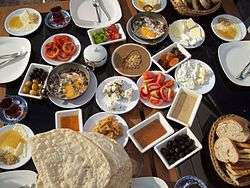
In Turkish cuisine, a typical breakfast consists of bread, cheese (beyaz peynir, kaşar etc.), butter, olives, eggs, tomatoes, cucumbers, jam, honey, and kaymak. Sucuk (spicy Turkish sausage), pastırma, börek, simit, poğaça and soups are eaten as a morning meal in Turkey. A common Turkish specialty for breakfast is called menemen, which is prepared with tomatoes, green peppers, onion, olive oil and eggs. Various soups (çorba) are also very common and traditional for Turkish breakfast; mainly chicken broth, lentil soup, and a national delicacy, tarhana soup (Turkish cereal food consisting of flour yogurt and vegetables fermented then dried; it is consumed as a soup by mixing it with stock or water) are most well known soups. Tripe soup, trotter soup, sheep's head soup are also traditionally very common all over Turkey for breakfast. The Turkish word for breakfast, kahvaltı, means "before coffee," (kahve, 'coffee'; altı, 'under').[62] but since after the First World War, during which the Ottoman Empire lost its coffee-producing territories, tea has displaced coffee as the everyday hot drink in Turkey. In Sirkeci district of Instanbul, Pide is a popular morning meal.[63]
United Kingdom and Ireland

In the United Kingdom, the classic breakfast has been the "full breakfast", which involves fried egg, scrambled egg or poached egg with bacon and sausages, usually with mushrooms, tomatoes, baked beans, fried bread, black pudding or white pudding and toast. A healthy and nutritious version consists of grilling the protein and using poached, rather than fried, eggs, and variations based on one egg, one protein and toast abound. The "full Scottish breakfast" tends to omit pork sausages and have beef sausages or haggis instead. At its most extensive it consists of eggs, square sausage, fried dumpling, potato scone, tomato, mushrooms, bacon beef links and fried bread. Originating in the British isles during the Victorian era, the full breakfast is among the most internationally recognised British dishes.[64]
Another traditional British breakfast consists of porridge, which has been consumed in Scotland as a staple food since the Middle Ages. The breakfast cereal Scott's Porage Oats was produced in Glasgow in 1880.[65] Before the arrival of American-style breakfast cereals in the early 20th century, dried bread soaked in hot milk or tea and porridge (boiled oats) was the common daily breakfast, while leftover vegetables (often, cabbage) and potatoes that hadn't been eaten the night before were often served re-fried; which became 'bubble-and-squeak';[66] in Ireland the dish is known as colcannon. Traditionally, breakfast would be served with a small amount of fruit, such as a slice of orange, believed to prevent the onset of scurvy.[67] Also traditional, but now less popular breakfasts included fish in the form of kippers (smoked herring) with poached egg and toast, and kedgeree (a Scoto-Indian smoked haddock, egg and rice dish originating in Colonial India). Most British breakfasts are consumed with tea, coffee or fruit juice.[66]
In the contemporary UK and Ireland, a weekday breakfast may involve a cereal dish, such as muesli, porridge or cereal, or toast spread with jam or marmalade. Tea and coffee remain equally popular accompaniments. Marmalade, originally a Portuguese confection, was a popular British spread to consume in the evening, before the Scots moved it to the breakfast table in the 18th century.[68]
In Old English, breakfast was known as morgenmete, meaning "morning meal".[2]
Hotels in the United Kingdom and Ireland
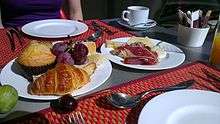
A continental breakfast in UK and Irish hotels normally consists of baked goods (fresh bread, toast, pastries such as croissants or pain au chocolat etc.) slices of cheese and cold meat, cereal, yogurts, fruit and drinks like coffee, tea or fruit juices.[69] Although this is the traditional breakfast in parts of continental Europe, elsewhere these breakfasts are common only in the hospitality sector (particularly in economy and limited service hotels with no restaurant, as they require little preparation).
Middle East and North Africa
Arab countries
Breakfast is often a quick meal, consisting of bread and dairy products, with tea and sometimes jam. Flat bread with olive oil and za'tar is also popular.[70]
Egypt
Most Egyptians begin the day with a light breakfast. Ful medames (dish of cooked fava beans), one of Egypt's several national dishes, is typical. It is seasoned with salt and cumin, garnished with vegetable oil and optionally with tahini, chopped parsley, chopped tomato, garlic, onion, lemon juice, chili pepper and often served topped with a boiled egg. It is scooped up and eaten with the staple whole wheat pita bread called Eish Masri or Eish Baladi (Egyptian Arabic: عيش [ʕeːʃ]; Modern Standard Arabic: ʿayš) and usually accompanied by taʿamiya (Egyptian Arabic: طعمية) which is the local variant of falafel made with fava beans, fresh cut homemade French fries and various fresh or pickled vegetables (called torshi). Several kinds of cheeses are popular, including gebna bēḍa or Domyati cheese, gebna rūmi (Roman cheese) which is similar to Pecorino Romano or Manchego, and Istanbuli cheese (a brined white cheese with peppers added to the brine which makes it spicy). Fried eggs with pastirma is also common breakfast foods in Egypt.
Morocco
.jpg)
For breakfast, many Moroccans eat bread, harsha (semolina griddle cakes), or msemen (oiled pancakes) with olive oil, tea, and different kinds of Moroccan crepes.[70]
Iran
Breakfast in Iran generally consists of different kinds of flatbread such as barbari, taftoon, sangak, lavash, white cheese, butter, jam and marmalade (morabba), honey, clotted cream (sar sheer), nuts and fresh/dried fruits, and black tea or coffee. Frequently breakfast can be as simple as butter and jam on bread with tea. Iranians prefer to drink their hot black tea with sugar. Traditional cooked dishes for breakfast include haleem (wheat and chicken/lamb/turkey porridge eaten with cinnamon) or kale pache (sheep's feet, stomach and other offal), adasi (green lentil soup), fried/boiled/soft-boiled eggs, omlet (eggs cooked in tomato sauce).
Israel
The Israeli breakfast is a mix of culinary influences from eastern Europe, agrarian Yishuv culture, North African cuisine and Levantine cuisine.[71] It usually consists of a range of cheeses along with sliced vegetables, scrambled eggs (or another kind of fried egg) [72][73] and bread, served with spreads like butter, jam or honey. The most commonly used vegetables are cucumbers, tomatoes, and red bell peppers; carrots, onions and radishes may also be included.[74] Cheeses include, at the very least, cottage cheese, quark or fromage blanc, and a local variety of gouda, and often Tzfatit and labneh too. Side dishes including pickled olives and herring may also be served. Typical Middle Eastern mezze such as Israeli salad, hummus, tehina and baba ghanoush, as well as Shakshouka and a variety of salads may be served.[74] The meal is most often accompanied by coffee, tea and orange juice.
Israeli hotels usually present this type of breakfast as a buffet.[75] Restaurants may prefer a pre-set "Israeli Breakfast" menu item.[76]
A typical Israeli meal could be either dairy- or meat-based, but not both. Only certain types of meat are considered kosher.
North America
Mexico
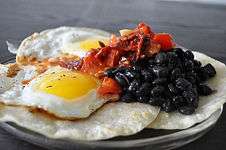
A traditional Mexican breakfast consists of eggs prepared in different ways (like Huevos rancheros), accompanied by beans with chile and tortillas. Also very traditional are chilaquiles (pieces of corn tortilla with a cheese and chile sauce) and entomatadas (a variation of the spicy enchiladas.)[77]
Canada and the United States

Breakfast in the United States and Canada often consists of some combination of hot or cold cereals, eggs, breakfast meats, and breakfast quick breads such as pancakes, waffles, or biscuits. Variants of the full breakfast and continental breakfast are also common. Coffee is a common breakfast beverage among adults, but is not popular with children. Tea is also widely consumed in Canada during breakfast. Orange juice, tomato juice, and other fruit juices are consumed by people of all ages. In the United States, 65% of coffee is drunk during breakfast hours.[78] Milk is also widely consumed, drunk either plain or prepared with various flavorings, such as chocolate or strawberry. The average starting time for breakfasts has been found to be 8:12 a.m. This varies from 8:08 a.m. in the South to 8:17 a.m. in the West.[79]
In the Southeastern United States, grits, and biscuits and gravy are popularly eaten at breakfast.[80]
In many regions around the country, the bagel, a ring-shaped bread product, is a common breakfast item. A bagel is often topped with seeds, such as sesame or poppy, or other spiced toppings, and is often served sliced in half, toasted, and spread with butter or cream cheese or other toppings.
Across the United States, breakfast sandwiches are a common choice for the first meal of the day. The archetypal breakfast sandwich is composed of egg, cheese, and cooked breakfast meat such as bacon or sausage, on a roll, although regional varietals are common. In New Jersey, bacon is often swapped out of the breakfast sandwich and replaced with a processed meat called Pork Roll (also known as Taylor Ham). Other areas alter the breakfast sandwich medium with regional favorites: in New York, the roll takes second seat to the bagel, and in the South, the biscuit is the vehicle of choice. A further twist of the classic breakfast sandwich is the breakfast burrito, which originates from Southwestern and Tex-Mex cuisines.
Another popular breakfast item in the United States is the donut. This is often consumed exclusive of other breakfast foods, though it's typically accompanied by coffee.
Oceania
Australia and New Zealand

Prior to the Second World War and the widespread adoption of household refrigerators, the traditional Australian breakfast consisted of grilled steaks and fried eggs, mainly because of the ready availability of beefsteak during that period. Although this is still eaten in the bush, very few urban Australians today would recall this breakfast format—but the steak-and-eggs breakfast has survived as the customary pre-landing breakfast of the United States Marine Corps, due to the Marines having copied it from Australian soldiers when the two countries campaigned together during the Pacific War.[81][82]
The majority of urban Australians eat commercially prepared cereal with pasteurised milk or yogurt and toast with preserves such as marmalade or vegemite[83] for breakfast.[84] Two of the most common cereals are cornflakes and a type of biscuit made from wheat, called Weet-bix. Fruit is also common at breakfast, either on the cereal or eaten separately. While not unusual, a cooked breakfast is more likely to be eaten on weekends or on special occasions either at home or at a café.[85] A cooked breakfast can include sausage, bacon, breakfast steaks, mushrooms, tomato, hash browns and pancakes, similar to both the British and American cooked breakfast. Breakfast habits differ more between age groups or families than between cities.[86]
Breakfast in New Zealand is very similar to the Australian breakfast. The range of processed breakfast cereals is vast and children are more likely to eat those that contain added sugar.[87] New Zealanders, particularly in winter, are likely to eat a hot oat cereal called "porridge". Porridge is typically served with milk, sugar, fruit or yogurt. Sliced bread which has been toasted and topped with preserves or spreads is a common alternative breakfast. Eating breakfast at a restaurant was unheard of until the 1990s; however cafes which serve breakfast until midday or all day are now common.[88] The Big Breakfast is the main item at cafes, which is similar to the British cooked breakfast, except that it seldom includes black pudding. Other common menu items are: eggs done how you like, eggs benedict, beans on toast, pancakes, cereal and yogurt, and smoothies. Breakfast nearly always includes coffee, tea or both, with children drinking milk either on their cereal, in a glass or hot milo. Recent concern has been raised about the cost of milk and some families being unable to afford it.[89]
New Zealand chains of the fast food franchise McDonald's offer a "kiwi big breakfast" which includes two sausages, hash brown, scrambled eggs, toasted muffin and choice of a small Filter coffee, Hot chocolate or tea.[90] Some NGOs and charities, such as the New Zealand Red Cross, provide breakfast to underclass primary school children.[91] Survey results released in 2013 claim that nearly half of all New Zealanders skip breakfast at least once a week with almost a third of those skipping breakfast up to three times a week.[92]
Fiji
In ethnically Fijian villages, breakfast often centers on tea served with milk and sugar, and food made out of flour: tovoi or babakau (a type of fried dough), pancakes, bread or biscuits with butter.[93] Sometimes a starch, such as cassava, taro in coconut milk, or rice, is served instead. Leftover fish or meat from the previous night's meal may be served as well.[94] Tea made from lemon leaves (called draunimoli)[93] and fruits such as pineapple, banana, papaya, plantain, and watermelon are also occasionally served.[95] In urban households, tea and cereals are often consumed.[93] Breakfast foods eaten by Fiji Indians often include a vegetable curry with roti and sometimes differ from the above.[93] Fijians living in Rotuma sometimes eat nuqa fish in tarotaro (fermented coconut yogurt), with fresh tropical fruits.[95]

Sub-Saharan Africa
Breakfast in Africa varies greatly from region to region.[96]
Nigeria
Nigeria has over 250 different ethnic groups,[97] with a corresponding variety of cuisines. For the Hausa of northern Nigeria, a typical breakfast consists of kosai (cakes made from ground beans which are then fried) or funkaso (wheat flour soaked for a day then fried and served with sugar). Both of these cakes can be served with porridge and sugar known as koko. For the south western Yoruba people (Ilé Yorùbá) one of the most common breakfasts is Ògì— a porridge made from corn, usually served with evaporated milk. Ògì is eaten with Acarajé (akara) or Moi moi.[98] Both are made from ground bean paste; akara is fried in oil, and moi moi is wrapped in leaves or foil and then steamed. Ògì can also be steamed in leaves to harden it and eaten with akara or moi moi for breakfast. English tea or malta is served as a breakfast drink. Another popular option in southwest Nigeria is Gari, which is eaten like a cereal. Gari, known in Brazil as farofa, is made from the root of cassava. For breakfast, it is soaked in water and sweetened with sugar.[99]
Senegal
Breakfast typically consists of café Touba,[lower-alpha 1][100] spiced coffee with abundant sugar sometimes consumed with dried milk,[101] or kinkeliba tea.[102] Small beignets and fresh fruit, including mangoes and bananas, are often part of a simple breakfast, and are accompanied by baguette[103] with various spreads: Chocoleca, a Nutella equivalent made from peanuts; butter; or processed mild cheese.
Somalia
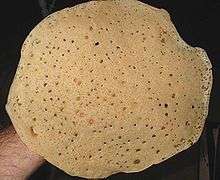
Breakfast (quraac) is an important meal for Somalis, who often start the day with some style of tea (shaah). The main dish is typically a pancake-like bread (canjeero or canjeelo) similar to Ethiopian injera, but smaller and thinner. It might also be eaten with a stew (maraq) or soup.[104] Lahoh is a pancake-like bread originating in Somalia, Djibouti and Yemen.[105][106] It is often eaten along with honey and ghee, and washed down with a cup of tea. During lunch, lahoh is sometimes consumed with curry, soup or stew.
Uganda
In Uganda, most tribes have different cuisines but the most popular breakfast dishes are Porridge and Katogo. Porridge is made by mixing maize flour or millet flour with water and bringing the mixture to a boil.[107] While Katogo is made from matoke (green bananas), peeled and cooked in the same pot with a sauce (Beef, peanuts, beans or greens), Katogo is served with tea or juice.[108] Both dishes are popular in all regions of Uganda.
Gallery
-

A croissant, served mainly in France and Western Europe.
-

A breakfast consisting of a novelty-stamped waffle, cantaloupe melon slices, grapes, and butter. Photo taken in Currier House of Harvard College
-
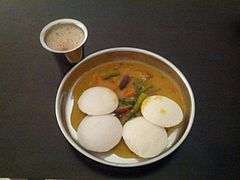
idli and sambar - a south Indian breakfast
-
Inflight airline meal – breakfast during a Thai Airways flight
See also
Notes
- ↑ The World Bank wrote that a progressive elimination of imported coffee seems common in poorer areas of Senegal as a result of the global recession of 2009: a Senegalese a restaurant owner stated, "We weren't used to consume [sic] the Tuba Coffee for breakfast, but since the crisis people drink it a lot, also children."
References
- ↑ "breakfast – definition of breakfast by the Free Online Dictionary, Thesaurus and Encyclopedia". Thefreedictionary.com. Retrieved 28 March 2012.
- 1 2 3 Anderson, Heather Arndt (2013). Breakfast: A History. AltaMira Press. ISBN 0759121656
- ↑ "History of breakfast". Retrieved 21 April 2011.
- 1 2 Giovannini M, Verduci E, Scaglioni S, Salvatici E, Bonza M, Riva E, Agostoni C (2008). "Breakfast: a good habit, not a repetitive custom". J Int Med Res. 36 (4): 613–24. doi:10.1177/147323000803600401. PMID 18652755.
- ↑ "Breakfast is 'most important meal'". BBC. 7 March 2003. Retrieved 3 June 2009.
- ↑ Maki KC, Phillips-Eakley AK, Smith KN (2016). "The Effects of Breakfast Consumption and Composition on Metabolic Wellness with a Focus on Carbohydrate Metabolism". Adv Nutr. 7 (3): 613S–21S. doi:10.3945/an.115.010314. PMID 27184288.
- ↑ Carroll AE (23 May 2016). "Sorry, There's Nothing Magical About Breakfast". The New York Times. Retrieved 23 May 2016.
- ↑ Leidy HJ, Gwin JA, Roenfeldt CA, Zino AZ, Shafer RS (2016). "Evaluating the Intervention-Based Evidence Surrounding the Causal Role of Breakfast on Markers of Weight Management, with Specific Focus on Breakfast Composition and Size.". Adv Nutr. 7 (3): 563S–75S. doi:10.3945/an.115.010223. PMID 27184285.
- ↑ Albala, Ken (2002). Hunting for Breakfast in Medieval and Early Modern Europe. Devon, UK.
- ↑ "Breakfast". Etymonline.com. Retrieved February 2, 2013.
- 1 2 3 4 Kong, Foong Ling; Ming Tsai; Chiong Liew (2002). The Food of Asia. Tuttle Publishing. p. 24. ISBN 978-0-7946-0146-1.
- ↑ Lane, Jo (28 February 2012). "A taste of Yangon: 6 must-try Burmese dishes". Travel Wire Asia. Hybrid News Limited. Retrieved 29 April 2012.
- ↑ Tin Cho Chaw (22 May 2009). "burmese paratha". Retrieved 29 April 2012.
- ↑ Köllner, Helmut; Axel Bruns (1998). Myanmar (Burma). Hunter Publishing. p. 215.
- ↑ "Chinese Cuisine". Retrieved 28 June 2012.
- ↑ "Cha chaan teng cheat sheet: What to order at the most popular eateries in Hong Kong". travel.cnn.com. Retrieved 30 December 2013.
- ↑ "A Taste of Chinese Breakfast". Retrieved 28 June 2012.
- 1 2 3 4 5 6 7 8 9 Ashkenazi, Michael; Jacob, Jeanne (2003). Food culture in Japan. Books.google.co.jp. pp. 119–120. Retrieved 29 June 2012.
- 1 2 Akiyama, Nobuo; Akiyama, Carol (999). Learn Japanese (Nihongo): the fast and fun way. Books.google.co.jp. p. 123. Retrieved 29 June 2012.
- ↑ "About". Retrieved 2 December 2013.
- 1 2 Regional Indian Recipes. Jaico Publishing House, 1970. ISBN 978-81-7224-035-6.
- ↑ "Types of Parathas". Retrieved 6 February 2013.
- ↑ Chire Bhaja or Fried Flaked Rice (East Indian-vegetarian)
- ↑ "Methi Thepla of Gujarat". Retrieved 6 February 2013.
- ↑ "Thalipeeth". Retrieved 15 December 2014.
- ↑ "Pakaplog". Pinoy Slang. Archived from the original on 5 December 2008. Retrieved 12 November 2008.
- ↑ Grupo 2: — Span201.002 – Patterson
- ↑ es:Desayuno#Rep.C3.BAblica Dominicana
- ↑ Deborah S. Hartz Authentic Jamaican breakfast 1 August 1991 Ocala Star-Banner page 44
- ↑ es:Desayuno#Panam.C3.A1
- ↑ es:Desayuno#Costa Rica
- ↑ Hubbard, Kirsten. "Nicaragua Food and Drink". Retrieved 6 February 2014.
- ↑ es:Desayuno#Guatemala
- ↑ es:Desayuno#HONDURAS
- ↑ "Continental Breakfast". Archived from the original on 30 December 2013.
- ↑ Hartsell, Carol (1 November 2013). "Key And Peele's 'Continental Breakfast' Might Be The Best Thing That's Ever Happened To Us". huffingtonpost.com.
- 1 2 Slavic Cuisine ISBN 9781156606315
- ↑ "Danish Food Culture: Breakfast". Denmark.dk. Archived from the original on 30 December 2008. Retrieved 28 February 2009.
- ↑ www.vesijalanjalki.org: liha Archived 27 May 2013 at the Wayback Machine.
- ↑ Escoffier, Georges Auguste (2002). Escoffier: The Complete Guide to the Art of Modern Cookery. New York: John Wiley and Sons. pp. Foreword. ISBN 978-0-471-29016-2.
- ↑ Austrian Cooking and Baking, Gretel Beer, ISBN 9780486232201
- ↑ Do we Greeks eat breakfast? Eleftherotypia newspaper Archived 3 February 2012 at the Wayback Machine.
- ↑ "Hidden milk shop in Athens(in Greek)" (in Greek). Dailysecret.com. Retrieved 28 March 2012.
- ↑ Gundel's Hungarian Cookbook, Karoly Gundel, page34
- ↑ József Venesz ISBN 963-13-0219-9: Corvina Press 1977.
- ↑ The Silver Spoon ISBN 88-7212-223-6, 1997 ed.
- 1 2 And the New Scandinavian Cuisine Marcus Samuelsson ISBN 0618109412
- ↑ Darmanin, Francis. A Guide To Maltese Cooking. Malta: Jumbo Productions. p. 14. ISBN 99909-79-00-6.
- ↑ Wintle, Michael (2006). "Diet and Modernization in The Netherlands During the Nineteenth and Early Twentieth Centuries". In Thomas M. Wilson. Food, Drink and Identity in Europe. Rodopi. pp. 63–84. ISBN 9789042020863. Retrieved 28 December 2012.
- ↑ "Nederland wil ontbijt terug op de kaart" (in Dutch). Nu.nl. 16 October 2012. Retrieved 6 November 2013.
- ↑ Vil bevare brødskiven på frokostbordet Byavisen.net (Norwegian)
- ↑ Polish Cooking Marianna Olszewska Heberle Penguin 2005 ISBN 9781440624759
- ↑ "Micul dejun în lume - unde și ce se mănâncă dimineața". Știri pe surse. Bucharest. 20 May 2015.
- ↑ "Ce consumă românii la micul dejun. Studiu Ipsos Research". economica.net. Bucharest. 14 February 2014.
- ↑ "Clătite la micul dejun, noul trend în nutriție". 30 August 2013.
- ↑ Iosebashvili, Irakli (4 December 2009). "Russia's national cuisine: Oladi pancakes". The Daily Telegraph. London. Archived from the original on 23 April 2012.
- ↑ The Gastronomical Me
- ↑ Molokhovets, Elena (1998). Classic Russian Cooking. Indiana University Press. p. 331.
- ↑ Unesco, The Mediterranean diet
- ↑ Rutiga kokboken, 2002, ISBN 91-534-1950-2
- ↑ Albert Wirz Doktor Birchers neue Weltordnung. Das Müesli als Stabilitätsfaktor NZZ Folio 04/97
- ↑ "Coffee Drinking Habits in Turkey". Lexio Philes. 24 September 2008. Retrieved 12 December 2013.
- ↑ Hasnat, Karim (1 June 2015). "World Breakfasts: Pide". www.savisto.com. Instanbul: Savisto. p. 52. Retrieved 30 July 2016.
Home and kitchen essentials
- ↑ Spencer, Colin (2003). British Food: An Extraordinary Thousand Years of History. Columbia University Press. ISBN 978-0-231-13110-0.
- ↑ "Scott's Porage – Our Heritage". Scott's Porage Oats. Retrieved 19 October 2010.
- 1 2 Caroline Conran, Traditional Cooking (British Cookery)1978 ISBN 0233 97053 3
- ↑ Dr E. J. C. Kendall, (1955) Scurvy during some British polar expeditions, 1875–1917 Polar Record, 7 , pp 467–485
- ↑ "Spread over centuries" (19 August 2003). The Age. 10 June 2015.
- ↑ "Difference between Continental and English breakfast". Travelwebdir.com. 8 October 2007. Retrieved 28 March 2012.
- 1 2 Special Events (18 July 2013). "The Art of Moroccan Cuisine – Cooking Classes in Morocco | Fes Cooking and Cultural Tours". Fescooking.com. Retrieved 23 August 2014.
- ↑ Gagnon, Lynn (15 May 2016). "The Israeli breakfast - Best in the world!". BonVoyageurs. Retrieved 19 May 2016.
- ↑ Dubois, Jill; Rosh, Mair. Cultures of the World: Israel. Singapore: Marshall Cavendish. p. 122. ISBN 9780761416692.
- ↑ Marks, Gil (2010). Encyclopedia of Jewish Food. Boston: Houghton Mifflin Harcourt. ISBN 9780544186316.
- 1 2 "Typical Israeli Breakfast: Bountiful". CBSNews.com. New York City. 6 November 2009.
- ↑ Torgerson, Dial (6 September 1979). "Israeli Breakfast ... is being replaced by the continental breakfast: coffee and a roll". Sarasota Herald-Tribune. Sarasota. pp. 8–CF. Retrieved 7 April 2013.
- ↑ Deane, Daniela (10 August 2012). "Smart Mouth: The delectable nature of Israeli breakfast". Washington Post. Washington, DC. Retrieved 7 April 2013.
- ↑ "Desayunos típicos alrededor del mundo". Retrieved 5 February 2014.
- ↑ "Specialty Coffee Statistics". e-importz.com. Retrieved 25 March 2012.
- ↑ When is dinner?
- ↑ Charles L., Cutler (2002). Tracks that speak: the legacy of Native American words in North American culture. USA: Houghton Mifflin. p. 28. ISBN 0-618-06510-5. Retrieved 26 September 2012.
- ↑ "Steak and Eggs Landing Party Breakfast at Monroe VFW hall – MonroeTalks.com calendar, powered by Helios Calendar". Monroetalks.com. 24 March 2012. Retrieved 29 June 2012.
- ↑ Terranova, a Remembrance – Steven J. Morabito – Google Books. Books.google.com.au. 16 December 2008. Retrieved 29 June 2012.
- ↑ "Vegemite". About-australia-shop.com. Retrieved 28 March 2012.
- ↑ Australia. Lonely Planet. 2004. p. 72. ISBN 1-74059-447-9.
- ↑ "What Do Australians Eat? Discover Australia Favorite Foods". Start-a-new-life-in-australia.com. Retrieved 28 March 2012.
- ↑ "What Australians eat for breakfast: an analysis of data from the 1995 National Nutrition Survey". Retrieved 29 June 2012.
- ↑ "Report Shows Eating Breakfast Helps Children's Adademic Performance" (PDF). Archived from the original (PDF) on 27 January 2012. Retrieved 29 June 2012.
- ↑ New Zealand. Lonely Planet. 2002. p. 79. ISBN 1-74059-196-8.
- ↑ "Fonterra takes fresh look at school milk – National – NZ Herald News". Nzherald.co.nz. 15 December 2011. Retrieved 28 March 2012.
- ↑ kiwi big breakfast
- ↑ Children offered breakfast to start school day Retrieved April 2013
- ↑ Back to work, back to school ... back to breakfast!
- 1 2 3 4 A. A. J. Jansen; Susan Parkinson; A. F. S. Robertson, eds. (1990). Food and Nutrition in Fiji: Food production, composition, and intake. Suva, Fiji: Department of Nutrition and Dietetics, Fiji School of Medicine. pp. 180, 183, 196, 234 241, 242, 255, 263, 311. OCLC 180559487.
- ↑ R. R. Nayacakalou (1972). Tradition and change in the Fijian village. South Pacific Social Sciences Association in association with the Institute of Pacific Studies. pp. 5, 146. OCLC 478256695.
- 1 2 Seeto, Lance (24 November 2013). "Weekend Food". The Fiji Times. p. 10.
- ↑ "Breakfast in Africa". mrbreakfast.com. Retrieved 31 August 2010.
- ↑ "Africa :: Nigeria". cia.gov.
- ↑ Dosti, Rose (25 February 1988). "Nigerian Bean Cakes Make a Hearty Breakfast". Los Angeles Times. Retrieved 15 January 2012.
- ↑ "Foods and Drinks". Motherland Nigeria. Retrieved 15 January 2012.
- ↑ Heltberg, Rasmus; Hossain, Naomi; Reva, Anna, eds. (2012). Living Through Crises: How the Food, Fuel, and Financial Shocks Affect the Poor. New Frontiers of Social Policy. Washington, DC: World Bank. p. 223. doi:10.1596/978-0-8213-8940-9. ISBN 978-0-8213-8940-9. OCLC 769421434. Retrieved 4 January 2013.
- ↑ Cherruau, Pierre. Reportage: Le café Touba fait battre les coeurs, PressAfrik, Dakar, 25 November 2009. Retrieved on 21 November 2012. (French)
- ↑ Mayer, Julie. "Breakfast in Ouakam, Dakar, Senegal", 22 July 2011. Retrieved on 21 November 2012. (French) (English)
- ↑ "A taste of Senegal: exotic and tantalizing,..", Prepared Foods, May 2008
- ↑ Abdullahi, pp.111–114.
- ↑ Mohamed Diriye Abdullahi, Culture and Customs of Somalia, (Greenwood Press: 2001), p. 113.
- ↑ Little Business Women
- ↑ "Porridge". Retrieved 27 March 2014.
- ↑ "Katogo". Monitor News paper. Retrieved 27 March 2014.
External links
| Wikimedia Commons has media related to Breakfast. |
| Look up breakfast in Wiktionary, the free dictionary. |
| Wikibooks Cookbook has a recipe/module on |
